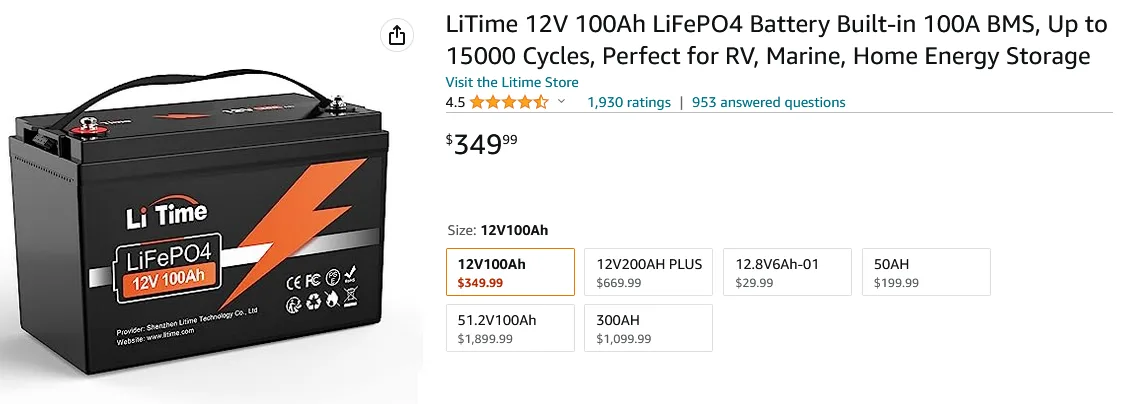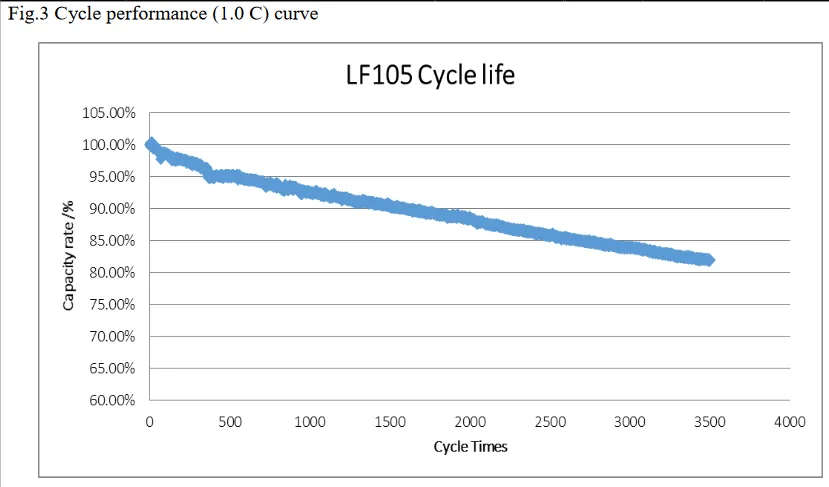If you ever wondered which are the cheapest batteries, you would say it’s lead acid.
Let’s compare the cost of lead acid and Lithium and see which one wins.
Recently someone came to me for advice on which battery to choose GEL, AGM, or LiFePO4.
We concluded that GEL and AGM are the best options if you don’t use your battery too often. This was for a van build which only gets’s used a few times a year.
But what if you use it daily?
Let’s use two batteries. Which would be your first choice:
Comparison of two frequently bought batteries
Renogy Deep Cycle AGM 12V 100AH Battery
- 12V 100Ah
- $190

LiTime 12V 100Ah LiFePO4 Battery
- 12V 100Ah
- $350

Available Wh in the battery
AGM battery
To use the battery for a long time, we should discharge it to 50% the capacity, also known as 50% DOD (depth of discharge). The total capacity for this battery becomes:
12V x 100Ah x 50% = 600Wh
Lithium Battery
To extend the lifespan of a lithium battery, we should cycle between 10% and 90% or 80% DOD, which means we can use 80% of the battery capacity.
12V x 100Ah x 80% = 960Wh
We now know that Lithium (LiFePO4) has more available energy per battery. But that’s not the whole story.
Let’s explore the weight of the battery in the next section
Weight of the battery
AGM Battery
The AGM battery has the following specifications:
- Dimension: 13.1 x 6.9 x 8.6 inch or 33 x 17.5 x 22cm
- Weight: 63.9 lbs or 29kg
We can now calculate the weight per available Wh of the battery:
63.9lbs / 600Wh = 0.1lbs/Wh
Lithium Battery
The Lithium battery has the following specifications:
- Dimensions: 13 x 6.77 x 8.43 inch or 33 x 17 x 21 cm
- Weight: 24.25 lbs or 11kg
We can calculate the weight per available Wh of the battery:
24.25lbs / 960Wh = 0.025lbs/Wh
We can see that Lithium or LiFePO4 is not just two times the weight, but if we account for usable capacity, then AGM is four times heavier than lithium.
C-rate of the Battery
The C-rate is the current at which a battery can charge and discharge to maintain its health and be as efficient as possible.
If you use a higher C-rate than normal the battery will still work, but at a reduced lifespan. Watch my video about C-rate to learn more about it.
Lead-Acid AGM
The charge and discharge rate is 0.2 for lead acid. This 100Ah battery can draw:
0.2C x 100Ah = 20A
20A x 12V = 240W
We can see that you should only draw 240W from this battery to increase its lifespan.
You should also have a solar charge with a maximum 20A charge current. If you go over 20A, then there will be more heat generation, and the lifespan of the battery will decrease.
Lithium battery
The charge and discharge rate for lithium can be from 0.5C to 1C. The BMS will limit the C-rating. In server rack batteries, this is often 0.5C, but in this battery, it is 1C because the BMS is rated at 100A. The cells themselves can handle 1C (max continuous charge/discharge), as we can see in the datasheet.
Now we can calculate the maximum current draw:
1C x 100Ah = 100A
100A x 12V = 1200W
We can see that a lithium battery can draw 1200W continuously.
Self-Discharge Temperature
Batteries self-discharge over time. This is due to chemical reactions, leakage, and time.
Lead-acid AGM
The lead-acid battery from Renogy has a 3% self-discharge rate each month at room temperature (77°F or 25°C). If the temperature is lower, this will decrease.
Other chemistries, like a flooded lead-acid battery, have a self-discharge rate of 5% each month, while GEL has 2%.
Lithium LiFePO4
Lithium has a self-discharge rate of 3% or lower. When the battery is fully charged, it will lose its capacity rather quickly at 10% per month, but when it is lower than 80%, it will become 0.5% self-discharge (source).
Lead acid AGM has a higher self-discharge rate than lithium, especially under 80% SOC.
Cycle life
Now let’s address the elephant in the room.
Cycle life is about how often you can charge and discharge the battery.
Lead-acid AGM
Lead acid batteries have a cycle life of 500 cycles at 50% discharge rate and 77°F (25°C) at 0.2C, as you can see in an image from the Renogy specification sheet:

We can also see that the battery lifespan will be heavily decreased to 230 cycles if the battery is discharged to 0%.
500 cycles / 365 days = 1.37 years
If you cycle the battery daily to 50%, you will get a little over a year’s worth. After that, you must recycle the battery as it will not hold any capacity.
Lithium LiFePO4
Lithium has a higher cycle life than lead-acid. This is a graph from a 105Ah EVE cell (I couldn’t find a 100Ah datasheet).

As you can see, we still have 80% capacity left after 3,500 cycles
3.500 cycles / 365 days = 9.58 years
To put it in perspective, this battery will still retain 80% of its capacity after nine and a half years of daily cycling. It is not specified if this was from 10 to 90% or from 0 to 100% (I suspect the first). You can still keep using the battery.
An important point we are overlooking here is the BMS in the battery. The BMS might not last as long as the battery cells themselves.
A LiFePO4 battery may even outlast you. Will Prowse talks about battery calendar aging, which means that the age of the battery will dictate its lifespan over the cycle life of the battery.
Cost per Wh
Now for the big conclusion, which one is cheaper? Lead acid or Lithium?
Let’s start with lead-acid
Lead Acid
We learned that we should only use 600Wh from the battery.
We also learned that we get 500 cycles out of it during normal use (0.2C).
This comes down to the following:
600Wh x 500 cycles = 300.000 Wh during the lifespan of the battery
$190 / 300.000 Wh = $0.0006/Wh
Lithium
We learned that we could use 80% of the battery capacity, which is 960Wh.
We also learned that we can get 3.500 cycles out of it and still have 80% capacity. I will keep it at this number because the BMS can fail too.
If you build a DIY LiFePO4 battery, you can replace the BMS anytime.
960Wh x 3.500 cycles = 3.360.000 Wh during the lifespan of the battery
$350 / 3.360.000 Wh = $0.0001/Wh
Conclusion
We can see that a Lithium or LiFePO4 battery will be six times cheaper than lead acid.
However, a lead-acid might still be a good choice if you use the battery as a backup or periodically like a seasonal van.
We also have to take the temperature into account. Lead acid can still charge at freezing temperatures, while LiFePO4 cannot (unless it has a heating function).
Another aspect which I should mention in safety. LiFePO4 batteries are very safe compared to Lithium-ion or even lead acid.
[custom-related-posts title=”Related Posts” none_text=”None found” order_by=”title” order=”ASC”]
I’m an off-grid enthusiast. I created this website to give clear and straight-to-the-point advice about solar power. I’m also the author of the book ‘Off-grid solar power simplified‘. Read more about me on my about page, check out my Youtube channel, or send me a message.
Hey thanks very much for a very in-depth study very informative thanks again kind regards Richard
Great work interesting reading I run 2 120a lithium in back of Cruiser love em and 9×35a in c/ van waiting till they fail and then switch to 2×200 lithium, less weight more usable amps.
Thank,
great work and knoweldege that you have shared
Great article. Learning lots.
I have a 12v 90AH Varta LDF professional leisure battery in my motorhome which is charged from the mains power via a smart charger. If i leave it on charge for long periods when the vehicle is not in use will this shorten the life of the battery?
Many thanks.
Look like it’s a lead-acid battery. It’s best to keep them charged at 100%.